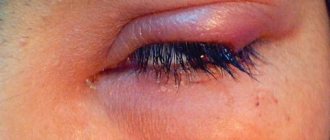Pain in the eyes can be a symptom of a concomitant illness - a cold, flu, migraine - or a sign of an ophthalmological disease that requires urgent treatment. The eyes can hurt inside and out, and there are pulsating sensations caused by overwork when the optic nerve is strained. When blurred vision and the appearance of mucous discharge are added, this indicates a serious illness. Corneal ulcers, burns, and mechanical damage may cause eye pain.
If severe pain occurs suddenly, you should immediately consult a doctor to prevent the development of serious consequences.
Causes of eye pain
Eye pain appears for various reasons, it can be stabbing, throbbing, or pressing. Depending on the nature and manifestation, it signals a disease.
Causes of eye discomfort:
- Fatigue of the eye muscles. Occurs during prolonged stress on the eyesight: working at a computer, reading in poor lighting, incorrectly selected glasses. Rest and relaxation exercises help eliminate the symptom.
- Migraine is accompanied by unpleasant sensations, difficulty focusing, and a feeling of squeezing.
- High pressure. It is characterized by pain in the frontal part of the head, complemented by pressure in the eye area.
- Inflammatory and infectious diseases. With conjunctivitis, blepharitis, dacryocystitis, itching, burning, redness of the eyelids, and discomfort appear. Antibacterial drug treatment is required.
- Dry eye syndrome. A person has a constant feeling of “sand in the eyes”; the cornea does not naturally moisten.
- Mechanical injuries, injuries to the cornea or eyeball caused by burns or penetration of a foreign body. Urgent medical intervention is required.
- Optic neuritis caused by autoimmune or infectious infection. Characterized by decreased visual acuity.
- Diseases of the ENT organs, close proximity of the upper respiratory tract and organs of vision. Appears with sinusitis, sinusitis, ARVI, influenza. A characteristic symptom is lacrimation, redness, and inflammation of the eyes.
- Dental ailments.
- Glaucoma, keratitis, inflammation of the trigeminal nerve, other ophthalmological diseases. If clouding occurs, vision deteriorates, or eye pain occurs, you should consult an ophthalmologist.
Classification of pain by nature
The nature of the pain indicates a possible disease.
- Aching is a symptom of keratitis, early stage glaucoma, dislocation of the eye lens, hypotension.
- Stitching pain is associated with inflammation and injury. Sometimes the eyes can sting in windy weather, with changes in atmospheric pressure, or with a sharp change in the temperature of the eyeball.
- A feeling of squeezing occurs with colds, flu, and migraines.
- Throbbing pain in one eye occurs with overwork, stress, or emotional outburst. Sometimes it is a symptom of traumatic brain injury, vascular pathologies of the brain, diseases that cause changes in the cornea and iris of the eye.
Additional symptoms more accurately indicate the disease. The doctor will help determine why the eyes hurt based on the patient's descriptions of the symptoms.
Ophthalmological diseases and their symptoms
Different eye pathologies are characterized by different symptoms. When there is pain in the eyes, it is important to pay attention to the nature, situation and frequency of occurrence of unpleasant sensations.
Styes are an inflammatory disease that causes pain when pressing on the eyelids and sometimes discharge of pus. Swelling of the eyelid, tearing, and sore eyes are the main symptoms of stye. Usually does not require drug treatment; washing with herbal decoctions is sufficient.
Uveitis is an inflammation of the choroid of the eye. It may be a consequence of hypothermia, metabolic disorders, or infectious infections. Symptoms of uveitis include light sensitivity, image distortion, and the sensation of a foreign body in the eye. The vascular web appears clearly, vision deteriorates. Urgent consultation with a doctor is necessary; in advanced cases, it can lead to loss of vision.
Astigmatism is the inability of light rays to focus on the retina of the eye. Irregular shape of the cornea or lens of the eye is the cause of astigmatism. The clinical picture corresponds to squeezing sensations in the head, tension, double vision, and blurred images. To look at objects you need to squint, a sharp pain occurs.
Glaucoma is a chronic disease characterized by changes in intraocular pressure. Soreness may appear first in the right eye and then in the left eye and vice versa. With glaucoma, sharp pain against the background of increased intraocular pressure can be of varying intensity. The disease is accompanied by additional symptoms:
- Sharp reaction to light;
- Pressure on the eyes;
- Slight dilation of the pupils;
- Nausea, vomiting;
- Blurred vision, decreased visual acuity;
- The appearance of a light tunnel.
Self-medication and untimely contact with specialists can lead to complete loss of vision.
A cataract is a developing clouding of the lens that causes blurred vision. With cataracts, light rays do not reach the retina of the eye. The main symptom is decreased vision and color distortion. In most cases there is no pain. Diagnosis of cataracts is possible only after examination.
Trachoma is a viral infection transmitted through household contact. The person feels pain of moderate intensity, and mucous discharge appears. If not treated on time, severe pain appears.
“Dry eye” syndrome is insufficient tear production caused by overwork, poor lighting, and dryness in the room. Symptoms are a dull aching pain, mucus appears, lacrimation, burning in the eyes.
Mechanical injury. A person may experience acute pain when a foreign object enters the area of the eyeball, into the eye tissue. Depending on the injury, the patient may require medical attention.
Bruise - injury to the eye due to strong pressure or impact with a non-sharp object. A bruise can provoke intraocular hemorrhage, manifested by acute pain and the formation of blood clots.
“The hostages had their eyes gouged out, their ears cut off, scalped, and then killed...”
The fact of massacres of civilians in the Azerbaijani city of Khojaly has numerous documentary evidence, including the stories of eyewitnesses - servicemen of the Russian army.
One of them, Yuri Girchenko, served in 1992 in a sapper battalion located in Agdam.
In his book “The Army of a State That Doesn’t Exist,” Yuri Girchenko says:
“...On the night of February 25-26, Armenian armed forces, with the support of tanks, infantry fighting vehicles and personnel of the Stepanakert 366th motorized rifle regiment, captured the city of Khojaly.”
According to Girchenko, not the entire regiment took part in the capture of Khojaly, but only the second battalion.
“Preparation for the assault took place in secret. But still, one of the leaders of the assault was precisely the commander of the second battalion. Why did it happen? And everything is very simple! The commander of the second battalion, almost all the officers, as well as all the warrant officers in the battalion were Armenians.”
That night, Girchenko recalls, they gathered all the Armenian soldiers in the regiment, as well as several volunteers of other nationalities, and, by prior agreement with the leaders of the Armenian detachments, began a joint assault on Khojaly.
“At 23.00, a two-hour massive shelling of the city began from tanks, infantry fighting vehicles, armored personnel carriers and modified Alazan installations. Then, from one o'clock in the morning to four o'clock in the morning, Armenian armed forces began an attack on the city. The soldiers of the 366th regiment did not enter the city. The resistance of the Khojaly garrison was quickly broken. By five o'clock in the morning a large fire broke out in the city. Almost the entire city was on fire..."
“Even before the shelling began, the Armenians shouted into the loudspeakers installed on the armored personnel carriers that a “free corridor” had been created for the population to leave Khojaly towards Agdam. The Armenians warned that only unarmed people would be released. And soon after the start of the assault, part of the population began to leave the city, trying to escape in the direction of Agdam.”
Yuri Girchenko notes that
“There was a second post, the existence of which the Azerbaijanis did not suspect. And from this post, from close range, the Armenians began shooting Khojaly refugees with machine guns. Moreover, they killed indiscriminately both armed and unarmed Azerbaijanis. They killed both adults and children, both young and old... The road gradually turned into a bloody and snowy mess, strewn with corpses of people ...”
As Girchenko writes, near the village of Nakhichevanik, refugees came under heavy fire from Armenian armored personnel carriers.
“Bloody corpses lay side by side, on top of each other. Part of the Azerbaijani column went towards the village of Gyulably, and there about two hundred people were captured. The surviving, almost maddened people still broke through to Agdam. But this is the fate only of those who went from Khojaly to Agdam along the route, leaving the village of Askeran on the left. But there was also a second stream of refugees.”
People who walked this route, according to Girchenko, walked around Askeran on the right side. They were also fired upon by the Armenians. They fired without looking for armed people among the fleeing people.
“Among this stream, the Armenians took hostages, killing some of them on the spot, and cutting off the heads of Azerbaijani riot police with axes. Some of the hostages had their eyes gouged out, their ears cut off, scalped, and then killed... Many refugees lost their way and simply froze along the way. And those who finally made it to Agdam had severe frostbite...”
“After the city of Khojaly was taken by the Armenians, about three hundred Azerbaijani civilians remained in it. All of them were taken hostage and taken within three days to Stepanakert and Askeran. The city of Khojaly was plundered...”
Many media outlets these days cite memories of other eyewitnesses to this terrible crime.
“People walking in front in a chain began to fall one after another. Among the women and children I noticed my wife. He started shouting for them to lie down on the ground. It was a terrible sight that I will never forget: strong, heavily armed Armenian guys shooting at defenseless women and children rushing about in the deep snow,” said Russian resident of Khojaly Sergei Bondarev.
“Two groups—apparently two families—were lying next to each other; the women’s hands were trying to cover the children. Some of them, including a little girl, had terrible wounds on their heads: in fact, only their face remained. The survivors said that they were finished off at point-blank range while they were already lying on the ground,” British journalists wrote from the scene of the tragedy.
According to an investigation by the Azerbaijani side, 613 people died during the tragic events in Khojaly. 63 of them are children. 8 families were completely lost, 130 children lost one of their parents, 25 were left orphans. 487 people were injured, 76 of them were children. Another 150 people are missing.
Traces of abuse were found on the bodies of 56 Khojaly residents. According to Le Monde journalists, among the dead were people with their eyes gouged out and scalped, bodies with their heads cut off, and pregnant women with their bellies ripped open. Some of the Khojaly residents who left the city escaped death from bullets, but froze while trying to get to Agdam through the mountains.
The fate of those who remained in Khojaly was also tragic. A correspondent for the Izvestia newspaper talked about how the bodies of those killed during the assault were brought to Agdam in order to exchange them for captured Armenians:
“You wouldn’t see anything like this in a nightmare: gouged out eyes, cut off ears, scalps, severed heads. Bundles of several corpses, which were dragged along the ground for a long time on ropes behind an armored personnel carrier. There is no limit to bullying."
No one was punished for this bloody massacre.
Serzh Sargsyan, then one of the Karabakh field commanders, and later the President of Armenia, initially said that the Armenians prefer “not to talk about it out loud.”
However, later Sargsyan spoke more frankly:
“Before Khojaly, the Azerbaijanis thought that they could joke with us, they thought that the Armenians were not capable of raising a hand against the civilian population. We managed to break this stereotype. That's what happened."
It pricks the eye like a needle - what is it?
In some cases, a person feels that the eye is being pierced like a needle. This syndrome is provoked by mechanical injuries and infections associated with infection in the eyeball area. In the first case, the entry of a foreign body, injury, or burn cause sensations of a shooting nature. If you experience discomfort, you should consult a doctor to more accurately determine why your eye is stinging. Sometimes stabbing pain is a nonspecific symptom of other ailments. Sometimes ophthalmology has nothing to do with acute eye pain. The reasons may be:
- Inflammation of the trigeminal facial nerve;
- Shingles affecting the eye area;
- Headaches, migraines;
- Pathologies of the upper respiratory tract.
Differential diagnosis helps determine the cause and prescribe the correct treatment.
Main reasons
Numerous eye diseases begin with pain in the corner of the eye. Let's study a number of such diseases in more detail:
- Blepharitis. The disease is characterized by significant inflammation of the skin of the eyelids. Itching and pain are felt both in the outer and inner corners of the eye.
- Obstruction of the lacrimal ducts. In this case, it does not matter whether the obstruction in front of us is complete or partial. This disease always causes discomfort, and the pain in the corner of the eye increases significantly when blinking. The cause of the development of the disease can be a tumor of the tear duct, as well as any eye injury.
- Angular conjunctivitis. A disease that develops as a result of a special bacterium entering the eye. This bacterium causes a characteristic lesion in the area of the corner of the eye, where pain, redness, itching, and small cracks develop.
- Canaliculitis. A disease characterized by inflammation of the tear ducts. Due to inflammation, discomfort appears in the corner of the eye. In the absence of proper treatment, the infection spreads into the nasal cavity, redness of the eyelids and swelling appear. In some cases, patients notice purulent discharge from the eyes.
- Herpes eye. This disease is very serious, pain in the eye is only its initial symptom. The more severe the pain develops, the more symptoms can be noted. Among them are swelling of the eyelids, photophobia and redness of the eyes.
- Dacryocystitis. This medical name refers to inflammation of the lacrimal sacs. Most often it occurs in one eye, less often in both eyes at once. An obligatory companion to such a disease is purulent discharge from the eye, which is released quite abundantly. Severe swelling may also be observed.
- Ingrown eyelash. If an eyelash grows in the corner of the eye, this always entails unpleasant painful sensations. However, the problem remains invisible to the naked eye.
How to treat eye diseases
At the first signs of visual impairment or pain, you should consult a doctor. Treatment and diagnosis depend on the severity of the disease and symptoms. Diagnosis includes identifying factors such as:
- Duration and intensity of pain;
- Whether the development of the syndrome is gradual or sudden;
- Patient use of medications.
Additionally, medical procedures are performed:
- Visual acuity testing;
- Ultrasound of the visual organs;
- Biomicroscopy;
- Measuring intraocular pressure;
- Taking tear and mucous material.
After the procedures, depending on the underlying cause, therapy is prescribed. Cataracts, glaucoma, mechanical injuries require surgical intervention. For inflammatory, infectious lesions, dry eye syndrome, drops are prescribed up to 5 times a day, antihistamines, anti-inflammatory, antimicrobial medications. If vision deteriorates, lenses and glasses are selected for constant wear or for work or reading.
Preventive measures
To prevent the development of pain and other side effects from wearing contact lenses, you must follow certain tips. Ophthalmologists recommend removing CL immediately after coming home, after which it is necessary to drip the eyes with drugs that promote the healing of microtraumas of the mucous membrane and nutrition of the organ (Solcoseryl). It is important to take out your contact lenses while you sleep. If you feel that the lens is hurting your eyes or rubbing one, it is recommended to use a moisturizing liquid. Lens lenses are an individual means for vision correction, so they cannot be used in conjunction with someone else.
Prevention
To prevent disturbances in the functioning of the visual organs, you need to take good care of your health and use only individual towels if there is a patient with an infectious eye disease in the house. Proper nutrition, eating foods containing vitamin A - carrots, blueberries. You should not try to treat your vision on your own if you feel severe acute pain, an injury has occurred, or a foreign object has entered the eye. Some pathologies are caused by impaired blood circulation in the organs of vision; timely contact with a specialist will help prevent serious complications and protect your vision!
When prescribing treatment, you need to follow the recommendations of the ophthalmologist, observe the regime of eye strain, give rest after an hour of working at the computer, and perform exercises to relax the muscles of the visual organ.









